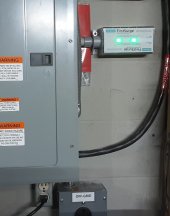MurphyGuy
It just needs a bigger hammer
- Joined
- May 20, 2020
- Messages
- 4,129
EMP Information:
Corrugated metal panels: While steel can be used as a shielding material, it is not optimal due to its relatively low conductivity as compared with economically available copper or aluminum.. That said, steel is a good "1st layer".
EMP is a general term that could refer to Nuclear EMP or Solar EMP. (Lightening is the 3rd type but we can ignore that) These two EMP's are very different animals and have about as much in common as sharks and dogs.. Yes, they can both bite you, but that's about the limit of what they have in common.
To protect against a solar EMP, you just disconnect everything from your utility grid and you're done.. Since we watch the Sun 24/7, it is not difficult to know when a large CME is headed our way and you'll have many hours of warning..
Nuclear EMP is a far more complicated issue and special precautions have to be taken. Simple corrugated panels screwed together and grounded are probably not going to protect anything. That's not to say the metal shielding won't have any attenuating affect, just not much of one.
The general rule of thumb is that you need a minimum of 40db of attenuation to protect most electronics most of the time. Basically, if you're trying to protect a clock radio or a battery charger, 40db is probably fine in most situations... but if you're trying to protect a laptop or a tablet, then 40db may not be enough.. The smaller the transistors, the more shielding you need, and computers have very small transistors.. To solve that problem, we put a Faraday cage inside another Faraday cage.. we call this "layering", and every good Faraday cage will have at least two layers.
Nuclear EMP has two forms 1) Conductive and 2) Radiative.
The conductive pulse travels along wires and a surge protector will work, but it needs to be a special type of surge protector with a nanosecond response time.. Seimens FS140 ($250) is a good example with a 1 ns response.. Your Walmart computer department surge strip has absolutely no chance of working.
The Radiative component is far more difficult to deal with and generally requires a Faraday cage. A good, well sealed, steel can will give you about 25 to 30 db of attenuation.. the same can in aluminum will give you about 40 db. Stick the aluminum can inside the steel can and you have a very good Faraday cage that will protect all but the most sensitive equipment from even a hot spot.
DO NOT ground a Faraday cage as the ground itself will act like an amplification antenna...
Corrugated metal panels: While steel can be used as a shielding material, it is not optimal due to its relatively low conductivity as compared with economically available copper or aluminum.. That said, steel is a good "1st layer".
EMP is a general term that could refer to Nuclear EMP or Solar EMP. (Lightening is the 3rd type but we can ignore that) These two EMP's are very different animals and have about as much in common as sharks and dogs.. Yes, they can both bite you, but that's about the limit of what they have in common.
To protect against a solar EMP, you just disconnect everything from your utility grid and you're done.. Since we watch the Sun 24/7, it is not difficult to know when a large CME is headed our way and you'll have many hours of warning..
Nuclear EMP is a far more complicated issue and special precautions have to be taken. Simple corrugated panels screwed together and grounded are probably not going to protect anything. That's not to say the metal shielding won't have any attenuating affect, just not much of one.
The general rule of thumb is that you need a minimum of 40db of attenuation to protect most electronics most of the time. Basically, if you're trying to protect a clock radio or a battery charger, 40db is probably fine in most situations... but if you're trying to protect a laptop or a tablet, then 40db may not be enough.. The smaller the transistors, the more shielding you need, and computers have very small transistors.. To solve that problem, we put a Faraday cage inside another Faraday cage.. we call this "layering", and every good Faraday cage will have at least two layers.
Nuclear EMP has two forms 1) Conductive and 2) Radiative.
The conductive pulse travels along wires and a surge protector will work, but it needs to be a special type of surge protector with a nanosecond response time.. Seimens FS140 ($250) is a good example with a 1 ns response.. Your Walmart computer department surge strip has absolutely no chance of working.
The Radiative component is far more difficult to deal with and generally requires a Faraday cage. A good, well sealed, steel can will give you about 25 to 30 db of attenuation.. the same can in aluminum will give you about 40 db. Stick the aluminum can inside the steel can and you have a very good Faraday cage that will protect all but the most sensitive equipment from even a hot spot.
DO NOT ground a Faraday cage as the ground itself will act like an amplification antenna...



